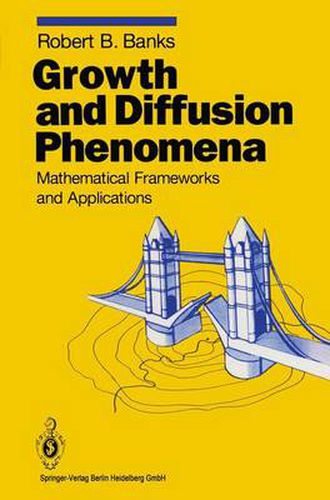Readings Newsletter
Become a Readings Member to make your shopping experience even easier.
Sign in or sign up for free!
You’re not far away from qualifying for FREE standard shipping within Australia
You’ve qualified for FREE standard shipping within Australia
The cart is loading…






This title is printed to order. This book may have been self-published. If so, we cannot guarantee the quality of the content. In the main most books will have gone through the editing process however some may not. We therefore suggest that you be aware of this before ordering this book. If in doubt check either the author or publisher’s details as we are unable to accept any returns unless they are faulty. Please contact us if you have any questions.
Diffusion and growth phenomena abound in the real world surrounding us. Someexamples: growth of the world’s population, growth rates of humans, public interest in news events, growth and decline of central city populations, pollution of rivers, adoption of agricultural innovations, and spreading of epidemics and migration of insects. These and numerous other phenomena are illustrations of typical growth and diffusion problems confronted in many branches of the physical, biological and social sciences as well as in various areas of agriculture, business, education, engineering medicine and public health. The book presents a large number of mathematical models to provide frameworks forthe analysis and display of many of these. The models developed and utilizedcommence with relatively simple exponential, logistic and normal distribution functions. Considerable attention is given to time dependent growth coefficients and carrying capacities. The topics of discrete and distributed time delays, spatial-temporal diffusion and diffusion with reaction are examined. Throughout the book there are a great many numerical examples. In addition and most importantly, there are more than 50 in-depth illustrations of the application of a particular framework ormodel based on real world problems. These examples provide the reader with an appreciation of the intrinsic nature of the phenomena involved. They address mainly readers from the physical, biological, and social sciences, as the only mathematical background assumed is elementary calculus. Methods are developed as required, and the reader can thus acquire useful tools for planning, analyzing, designing,and evaluating studies of growth transfer and diffusion phenomena. The book draws on the author’s own hands-on experience in problems of environmental diffusion and dispersion, as well as in technology transfer and innovation diffusion.
$9.00 standard shipping within Australia
FREE standard shipping within Australia for orders over $100.00
Express & International shipping calculated at checkout
This title is printed to order. This book may have been self-published. If so, we cannot guarantee the quality of the content. In the main most books will have gone through the editing process however some may not. We therefore suggest that you be aware of this before ordering this book. If in doubt check either the author or publisher’s details as we are unable to accept any returns unless they are faulty. Please contact us if you have any questions.
Diffusion and growth phenomena abound in the real world surrounding us. Someexamples: growth of the world’s population, growth rates of humans, public interest in news events, growth and decline of central city populations, pollution of rivers, adoption of agricultural innovations, and spreading of epidemics and migration of insects. These and numerous other phenomena are illustrations of typical growth and diffusion problems confronted in many branches of the physical, biological and social sciences as well as in various areas of agriculture, business, education, engineering medicine and public health. The book presents a large number of mathematical models to provide frameworks forthe analysis and display of many of these. The models developed and utilizedcommence with relatively simple exponential, logistic and normal distribution functions. Considerable attention is given to time dependent growth coefficients and carrying capacities. The topics of discrete and distributed time delays, spatial-temporal diffusion and diffusion with reaction are examined. Throughout the book there are a great many numerical examples. In addition and most importantly, there are more than 50 in-depth illustrations of the application of a particular framework ormodel based on real world problems. These examples provide the reader with an appreciation of the intrinsic nature of the phenomena involved. They address mainly readers from the physical, biological, and social sciences, as the only mathematical background assumed is elementary calculus. Methods are developed as required, and the reader can thus acquire useful tools for planning, analyzing, designing,and evaluating studies of growth transfer and diffusion phenomena. The book draws on the author’s own hands-on experience in problems of environmental diffusion and dispersion, as well as in technology transfer and innovation diffusion.